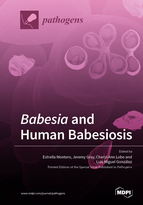Babesia and Human Babesiosis
A special issue of Pathogens (ISSN 2076-0817). This special issue belongs to the section "Parasitic Pathogens".
Deadline for manuscript submissions: closed (31 December 2021) | Viewed by 76829
Special Issue Editors
Interests: Babesia divergens; Babesia microti; Babesiosis; Asexual life cycle development and propagation; Invasion and egress molecular mechanisms; Host–pathogen interactions; Cellular architecture; Diagnosis
Interests: Ticks; Tick-borne diseases; Babesiosis
Interests: Mechanisms of invasion, Intracellular development, Multiplication and egress of the intra-erythrocytic parasites-Plasmodium falciparum, Babesia divergens and Babesia microti; Host RBC receptors and parasite ligands and changes mediated by the parasite to the RBC; Pathogenesis of Babesiosis in sickle cell and other hemoglobinopathies
Interests: Babesia divergens; Babesia microti; Babesiosis; Asexual life cycle development and propagation; Invasion and egress molecular mechanisms; Host–pathogen interactions; Cellular architecture; Diagnosis
Special Issue Information
Dear Colleagues,
Babesiosis, caused by tick-transmitted intraerythrocytic parasites (Babesia spp.), occurs worldwide. The disease mainly affects livestock, but records of infections in humans, sometimes as a result of blood transfusions, are increasing, and the disease is considered to be emerging worldwide. At least five Babesia spp. that infect humans have been taxonomically identified, and there are other unnamed zoonotic species. The papers in this issue will be divided into three sections.
- Aspects of the basic biology of Babesia will be described, for example, taxonomy, lifecycles, parasite–host interactions, modifications that the human RBC undergoes post-Babesia invasion, the process of infection of ticks and vertebrate hosts, and general pathogenesis and immunology highlighting the pathogenesis of babesiosis in sickle cell and other hemoglobinopathies. In vitro and in vivo culture systems, multi-omics (genomic, transcriptomic, proteomics, and metabolomics), transfection systems available for several Babesia spp., and current and emerging microscopic techniques will also be covered since they contribute to our understanding of important molecular mechanisms and cellular aspects of Babesia spp.
- Papers will address the pathology and epidemiology of the diseases caused by the main zoonotic parasite species, including the eco-epidemiology of tick vectors and the impact of climate change on them. The role of concurrent infections with other tick-borne pathogens will be highlighted, diagnostic problems emphasized, and the screening of blood in blood banks to prevent transfusion transmission will be discussed.
- Papers will also describe hitherto unidentified Babesia parasites that continue to emerge, most likely from wildlife, for which neither tick vector species nor vertebrate reservoir host species are currently known. Lastly, current and new therapies for infected patients, and measures to prevent infections will be considered.
The objective of this Special Issue is to provide a comprehensive and holistic view of Babesia parasites, particularly those species that can infect humans, and to explore the nature of the diseases they cause.
Dr. Estrella Montero
Dr. Jeremy Gray
Dr. Cheryl Ann Lobo
Dr. Luis Miguel González
Guest Editors
Manuscript Submission Information
Manuscripts should be submitted online at www.mdpi.com by registering and logging in to this website. Once you are registered, click here to go to the submission form. Manuscripts can be submitted until the deadline. All submissions that pass pre-check are peer-reviewed. Accepted papers will be published continuously in the journal (as soon as accepted) and will be listed together on the special issue website. Research articles, review articles as well as short communications are invited. For planned papers, a title and short abstract (about 100 words) can be sent to the Editorial Office for announcement on this website.
Submitted manuscripts should not have been published previously, nor be under consideration for publication elsewhere (except conference proceedings papers). All manuscripts are thoroughly refereed through a single-blind peer-review process. A guide for authors and other relevant information for submission of manuscripts is available on the Instructions for Authors page. Pathogens is an international peer-reviewed open access monthly journal published by MDPI.
Please visit the Instructions for Authors page before submitting a manuscript. The Article Processing Charge (APC) for publication in this open access journal is 2700 CHF (Swiss Francs). Submitted papers should be well formatted and use good English. Authors may use MDPI's English editing service prior to publication or during author revisions.
Keywords
- Babesia spp.
- human babesiosis
- molecular and cellular biology
- pathogenesis
- transmission
- epidemiology
- climate change
- treatment







